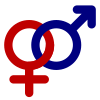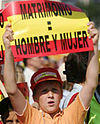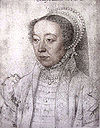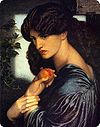Instructions
The layout design for these subpages is at Portal:Feminism/Selected article/Layout.
- Add a new Selected article to the next available subpage.
- The "blurb" for all selected articles should be approximately 10 lines, for appropriate formatting in the portal main page.
- Update "max=" to new total for its {{Random portal component}} on the main page.
Selected articles list
Portal:Feminism/Selected article/1

feminist
Mary Wollstonecraft, is one of the earliest works of feminist philosophy. In it, Wollstonecraft responds to the educational and political theorists of the eighteenth century who wanted to deny women an education. She argues that women ought to have an education
commensurate with their position in society, claiming that women are essential to the nation because they educate its children and because they could be "companions" to their husbands, rather than mere wives. Instead of viewing women as ornaments to society or property to be traded in marriage, Wollstonecraft maintains that they are human beings deserving of the same fundamental rights as men. Wollstonecraft was prompted to write the
Rights of Woman by
Charles Maurice de Talleyrand-Périgord's 1791 report to the French
National Assembly
Portal:Feminism/Selected article/2
scholar-officials. The military also provided a means for advancement in Song society for those who became officers, even though soldiers were not highly-respected members of society. Although certain domestic and familial duties were expected of women in Song society, they nonetheless enjoyed a wide range of social and legal rights in an otherwise
patriarchal society. Women's improved rights to property came gradually with the increasing value of
dowries offered by brides' families.
Daoism and
Buddhism were the dominant religions of China in the Song era, the latter deeply impacting many beliefs and principles of
Neo-Confucianism throughout the dynasty. The Song justice system was maintained by policing sheriffs, investigators, official coroners, and exam-drafted officials who acted as
magistrates
Portal:Feminism/Selected article/3

The École Polytechnique de Montréal in
Montreal,
Quebec. Twenty-five year-old
Marc Lépine, armed with a legally-obtained
semi-automatic rifle and a hunting knife, shot twenty-eight people, killing fourteen (all of them women) and injuring the other fourteen before killing himself. He began his attack by entering a classroom at the university, where he separated the men and women students from each other. After claiming that he was "fighting
feminism", he shot all nine women in the room, killing six. He then moved through corridors, the cafeteria, and another classroom, specifically targeting women to shoot. He killed fourteen women and injured four men and ten women in just under twenty minutes before turning the gun on himself. Lépine's suicide note claimed political motives and blamed feminists for ruining his life. The note include a list of nineteen Quebec women whom Lépine considered to be feminists and apparently wished to kill. Since the attack, Canadians have debated various interpretations of the events, their significance, and Lépine's motives. The massacre is regarded by most feminists and many official perspectives as an
anti-feminist attack and representative of wider societal violence against women; the anniversary of the massacre is commemorated as the
National Day of Remembrance and Action on Violence Against Women. The incident led to more stringent
gun control laws in
Canada, and changes in the tactical response of police to shootings, which were later credited with minimizing casualties at the
Dawson College shootings
Portal:Feminism/Selected article/4
The , and earning numerous badges that can teach lifelong skills. Girl Scouts are recognized for their achievements through rank advancement and various special awards. GSUSA has programs for girls with special interests, such as water-based activities. Membership is organized according to age levels with activities appropriate to each age group.
Portal:Feminism/Selected article/5
Since the loosening of government controls over society in the early 1980s,
social organisations
or the government of the PRC.
Portal:Feminism/Selected article/6
eighteenth-century British conduct book drew on several literary traditions, such as advice manuals and religious narratives. There was an explosion in the number of conduct books published during the second half of the eighteenth century, and Wollstonecraft took advantage of this burgeoning market when she published
Thoughts. However, the book was only moderately successful: it was favourably reviewed, but only by one journal and it was reprinted only once. Although it was excerpted in popular magazines of the time, it was not republished until the rise of
feminist literary criticism
Portal:Feminism/Selected article/7
The , and government benefits.
Portal:Feminism/Selected article/8

constitutional right
, overturning several state laws against abortion. It remains one of the most controversial decisions in Supreme Court history. The decision in Roe v. Wade has sparked a decades-long national debate over when abortion should be legal; the role of the Supreme Court in constitutional adjudication; and the role of religious views in the political sphere. Roe v. Wade became one of the most politically significant Supreme Court decisions in history, reshaping national politics, dividing the nation into "pro-choice" and "pro-life" camps, and inspiring grassroots activism. Roe sparked widespread opposition, from those who viewed the Court's decision as illegitimate for straying too far from the text and history of the Constitution, as well as from those motivated by religious and moral beliefs about the inviolability of fetal life. It also attracted widespread support, from those who view the decision as necessary to achieve women's equality and personal freedom.
Portal:Feminism/Selected article/9
The .
Portal:Feminism/Selected article/10
Christian church
. Leland's work remained obscure until the 1950s, when other theories about, and claims of, "pagan witchcraft" survivals began to be widely discussed. Aradia began to be examined within the wider context of such claims. Scholars are divided, with some dismissing Leland's assertion regarding the origins of the manuscript, and others arguing for its authenticity as a unique documentation of folk beliefs.
Portal:Feminism/Selected article/11
The Today Show, it has been the center of several controversies. Customers and scientists question the accuracy of the test; and
legal action is being pursued against Acu-Gen as well as a major supplier of the test kit. Concerns have also been raised by
bioethicists that use of the test could lead to practices such as
sex selection and Acu-Gen has allegedly used the test to illegally offer
medical diagnoses
Portal:Feminism/Selected article/12
. Approximately 4,500 same-sex couples have married in Spain during the first year of the law.
Portal:Feminism/Selected article/13
The . If fertilisation and pregnancy do not ensue, the uterus sheds the lining and a new menstrual cycle begins.
Portal:Feminism/Selected article/14
academic critics, who praise its linguistic energy, sharp social
satire
Portal:Feminism/Selected article/15
The
Directive Principles of State Policy
are guidelines for the framing of laws by the government. The Fundamental Duties are defined as the moral obligations of all citizens to help to promote a spirit of patriotism and to uphold the unity of India. Like the Directive Principles, they are not legally enforceable.
Portal:Feminism/Selected article/16
Eisner Awards (one of which it won). A French translation of
Fun Home was serialized in the newspaper
Libération; the book was an official selection of the
Angoulême International Comics Festival and has been the subject of an academic conference in France.
Fun Home also generated controversy: a public library in
Missouri
Portal:Feminism/Selected article/17
Under
became ducking stool. The stool consisted of a chair attached to a lever, suspended over a body of water; the prisoner was strapped into the chair and dunked into the water for her punishment.
Portal:Feminism/Selected article/18
Fontainebleau. She saw Italian and French craftsmen at work together, forging the style that became known as the first
School of Fontainebleau
Portal:Feminism/Selected article/19
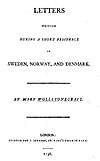
feminist
Mary Wollstonecraft. The twenty-five letters cover a wide range of topics, from sociological reflections on
Scandinavia and its peoples to philosophical questions regarding identity. Published by Wollstonecraft's career-long publisher,
Joseph Johnson, it was the last work issued during her lifetime. Wollstonecraft undertook her tour of Sweden, Norway, and Denmark in order to retrieve a stolen treasure ship for her lover,
Gilbert Imlay. Believing that the journey would restore their strained relationship, she eagerly set off. However, over the course of the three months she spent in Scandinavia, she realized that Imlay had no intention of renewing the relationship. The letters which constitute the text, drawn from her journal and from missives she sent to Imlay, reflect her anger and melancholy over his repeated betrayals.
Letters Written in Sweden is therefore both a travel narrative and an autobiographical
memoir. Using the rhetoric of the
sublime
Portal:Feminism/Selected article/20
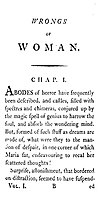
gothic novel revolves around the story of a woman imprisoned in an insane asylum by her husband. It focuses on the societal rather than the individual "wrongs of woman" and criticizes what Wollstonecraft viewed as the
patriarchal institution of marriage in eighteenth-century Britain and the legal system that protected it. However, the heroine's inability to relinquish her romantic fantasies also indicts women for wallowing in a false and damaging
sentimentalism. The novel pioneered the celebration of female sexuality and cross-class identification between women. Such themes, coupled with the publication of Godwin's scandalous
Memoirs of Wollstonecraft's life, made the novel unpopular at the time it was published. Twentieth-century
feminist critics
Portal:Feminism/Selected article/21
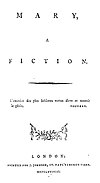
feminist
Mary Wollstonecraft. It tells the tragic story of a heroine's successive "
romantic friendships" with a woman and a man. Composed while Wollstonecraft was a
governess in Ireland, the novel was published in
1788 shortly after her summary dismissal and her momentous decision to embark on a writing career, a precarious and disreputable profession for women in eighteenth-century Britain. Inspired by
Jean-Jacques Rousseau's idea that geniuses are self-taught, Wollstonecraft chose a rational, self-taught heroine, Mary, as the central character of her novel. Helping to redefine
genius
Portal:Feminism/Selected article/22
jump-rope rhyme, a
lament, an
idyll, a
ballad, a lecture, a court trial and several types of songs. The novella's central themes include the effects of story-telling perspectives, double standards between the genders and the classes, and the fairness of justice. Atwood had previously used characters and storylines from Greek mythology in fiction such as her novel
The Robber Bride, short story
The Elysium Lifestyle Mansions and poems "Circe: Mud Poems" and "Helen of Troy Does Counter Dancing" but used
Robert Graves’
The Greek Myths and
E. V. Rieu and
D. C. H. Rieu
Portal:Feminism/Selected article/23
Customs Court
. Although few critics rate The Well highly as a work of literature, its treatment of sexuality and gender continues to inspire study and debate.
Portal:Feminism/Selected article/24
Congressional
lobbying through the National Non-Partisan Lobby on Civil and Democratic Rights. The sorority works with communities through service initiatives and progressive programs relating to education, family, health, and business.
Portal:Feminism/Selected article/25
The . In the French Lives she portrays women sympathetically, explaining their political and social restrictions and arguing that women can be productive members of society if given the proper educational and social opportunities.
Portal:Feminism/Selected article/26
John Waters and criticized the colorful production design. The lead actors were praised for their performances but some of the characters were described as
stereotypical
Portal:Feminism/Selected article/27
Noir, and together with
El Cazador de la Bruja, these series constitute a
trilogy exploring the "
girls-with-guns" genre. The production of
Madlax began in 2002 but it wasn’t until
Yōsuke Kuroda joined the project that the series took its final form. While the critics noted the resulting similarities between
Noir and
Madlax, they also acknowledged the differences, such as the latter's less episodic and more plot-driven style and, in particular contrast to the predominantly
realistic Noir, incorporation of many
supernatural elements
Portal:Feminism/Selected article/28
feminist retelling from
Ceres's point of view, Shelley emphasises the separation of mother and daughter and the strength offered by a community of women. Ceres represents life and love, and Pluto represents death and violence. The
genres of the text also reflect gender debates of the time. Percy contributed in the lyric verse form traditionally dominated by men; Mary created a drama with elements common to early nineteenth-century women's writing: details of everyday life and empathetic dialogue.
Proserpine is part of a female literary tradition which, as
feminist literary critic Susan Gubar
Portal:Feminism/Selected article/29
autobiographical fiction, but the prevailing critical view characterizes it as an autobiography, a genre she attempts to critique, change, and expand. The book covers topics common to autobiographies written by black American women in the years following the
civil rights movement
Nominations
- Adding articles
- Feel free to add
Featured quality
Feminism-related articles to the above list.
- If you are unsure or do not know how to add an entry, feel free to post a question, suggestion or nomination here below, or at the talk page Portal talk:Feminism.










